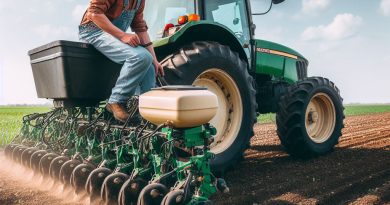Guidelines for Weed Control in Crops
Last Updated on March 2, 2024
Introduction
Weed control is crucial for crop production as weeds can compete for nutrients, water, and sunlight. It is crucial for several reasons.
Weeds compete with crops for essential resources like water, nutrients, and sunlight, reducing yields and quality.
They can host pests and diseases, increasing the risk of crop damage. Additionally, weeds can impede harvesting operations, leading to losses in efficiency and profitability.
Effective weed management practices also contribute to sustainable agriculture by minimizing soil erosion and preserving biodiversity.
Overall, weed control ensures optimal crop growth, reduces economic losses, and supports food security by maintaining high agricultural productivity.
The purpose of this blog post is to discuss guidelines for effective weed control in crops to improve yields and minimize crop damage.
Understanding Weeds
Definition and types of weeds
Weeds are unwanted plants that compete with cultivated crops for resources, including light, water, and nutrients.
- Annual weeds: Complete their life cycle within a year.
- Perennial weeds: Live for multiple years, regenerating from their roots or underground structures.
Impact of weeds on crop growth and yield
Weeds negatively affect crop growth and ultimately reduce yield due to various reasons.
- Competition for resources: Weeds compete for essential resources, limiting their availability to crops.
- Allelopathy: Some weeds release chemicals that inhibit crop growth, leading to yield reduction.
- Physical interference: Weeds obstruct sunlight, reducing photosynthesis and stunting crop growth.
- Pest and disease harborage: Weeds can provide shelter for pests and diseases, increasing their prevalence.
Common weeds in agricultural settings
- Pigweed (Amaranthus spp.): A common annual weed known for its fast growth and high competitiveness.
- Johnson grass (Sorghum halepense): A perennial weed that spreads through rhizomes, outcompeting crops.
- Common lambsquarters (Chenopodium album): An annual weed that outcompetes crops for essential nutrients.
- Field bindweed (Convolvulus arvensis): A perennial weed that grows rapidly and competes for resources.
- Canada thistle (Cirsium arvense): A perennial weed that spreads through an extensive root system.
To effectively control weeds, it is crucial to understand their impact on crop growth and the specific types commonly found in agriculture.
One approach for weed control is the use of herbicides, which selectively target and eliminate weeds without harming crops.
However, it is important to follow guidelines and apply herbicides judiciously to minimize adverse effects on the environment and non-target organisms.
cultural weed control
Another strategy is cultural weed control, which includes practices that suppress weed growth and promote crop competitiveness.
- Crop rotation: Rotating crops disrupts weed life cycles and reduces weed populations.
- Mulching: Applying organic matter or plastic mulches helps smother weeds and conserve soil moisture.
- Mechanical weed removal: Hand-weeding or using mechanical tools can be effective for smaller areas.
- Use of cover crops: Planting cover crops competes with weeds and reduces their growth.
Furthermore, integrated weed management combines multiple strategies for sustainable weed control.
- Biological control: Using natural enemies such as insects, fungi, or pathogens to control weed populations.
- Crop competition: Selecting crop varieties with vigorous growth and dense canopy to suppress weed growth.
- Precision farming: Using technologies like GPS-guided equipment for targeted herbicide application.
It is crucial for farmers to regularly monitor their fields for weed presence and take proactive measures to prevent weed establishment.
Early detection and control are vital to minimize the negative impact of weeds on crop growth and yield.
In essence, understanding weeds’ definition, types, and impact on crops is essential for effective weed control in agricultural settings.
By implementing appropriate strategies, such as herbicide usage, cultural practices, and integrated management, farmers can mitigate weed competition and maximize crop productivity.
Regular monitoring and proactive measures are key to successful weed control.
Pre-Planting Weed Control Methods
Achieving effective weed control is crucial in ensuring the successful growth and productivity of crops.
Before the actual planting process, several pre-planting weed control methods can be implemented to minimize weed seed viability and reduce the competition faced by crops.
These methods include soil preparation techniques, cover cropping and smothering crops, mulching and plastic sheeting, and the use of pre-emergent herbicides.
Soil Preparation Techniques to Reduce Weed Seed Viability
One of the fundamental steps in weed control is preparing the soil appropriately to inhibit weed growth.
By disrupting the soil surface, weed seeds present in the top layer are exposed to unfavorable conditions, hindering their germination and reducing their viability.
Some effective techniques for soil preparation include:
- Tilling or plowing the soil to bury weed seeds deeper, where they are less likely to germinate.
- Using mechanical weeders or cultivators to uproot emerging weeds before they become established.
- Employing flame weeding or thermal weed control methods to heat the soil surface and destroy weed seeds.
These practices can significantly reduce the weed seed bank in the soil, providing a favorable environment for the crop without the excessive competition from weeds.
Cover Cropping and Smother Crops
Utilizing cover crops and smother crops is another effective pre-planting weed control strategy.
Cover crops are typically fast-growing plants that are grown to cover the soil and suppress weed growth.
They compete with weeds for resources such as sunlight, water, and nutrients, thus reducing weed establishment.
Additionally, cover crops can improve soil fertility and structure, benefiting the subsequent crop.
Smother crops, on the other hand, have allelopathic properties that hinder weed seed germination and growth.
Their dense canopy and aggressive root systems help choke out weeds and create an unfavorable environment for them to thrive.
Some common examples of smother crops are buckwheat, sorghum-sudangrass, and hairy vetch.
Mulching and Plastic Sheeting
Mulching and plastic sheeting are widely employed pre-planting weed control techniques that provide a physical barrier to inhibit weed growth.
Mulch, such as straw, wood chips, or shredded leaves, is spread over the soil surface around the crop plants.
This layer suppresses weed emergence by blocking light and preventing weed seeds from receiving the necessary conditions for germination.
Plastic sheeting, often used in commercial agriculture, is laid over prepared soil and secured with soil or metal pins.
It acts as a physical barrier that deprives weeds of light and prevents their growth.
Plastic sheeting also helps retain soil moisture and regulate soil temperature, promoting optimal conditions for crop growth.
Pre-emergent Herbicides
In some cases, particularly in large-scale agricultural operations, the use of pre-emergent herbicides may be necessary to control weeds before they emerge.
These herbicides are applied to the soil before planting, forming a barrier that inhibits weed seed germination and growth.
It is important to carefully follow the instructions and safety precautions provided by the herbicide manufacturer to ensure effective and responsible use.
Pre-emergent herbicides can be selective or non-selective, meaning they either target specific weed species or inhibit the growth of all plants.
It is essential to choose the appropriate herbicide based on the weed species present and the type of crop being grown to avoid any adverse effects on the crop itself.
Overall, implementing pre-planting weed control methods plays a vital role in establishing a weed-free environment for crops, enabling them to thrive without unnecessary competition.
By incorporating soil preparation techniques, cover cropping, mulching, and pre-emergent herbicides, farmers can effectively manage weed populations and pave the way for successful crop growth.
Read: Crop Diversity Benefits Revealed
In-Season Weed Control Methods
In-season weed control is crucial for maintaining the health and productivity of crops.
By implementing effective methods, farmers can minimize weed competition and ensure a bountiful harvest.
This section explores various in-season weed control techniques that can be employed to combat weed growth.
Cultural practices to prevent weed growth
- Crop rotation and intercropping: Crop rotation involves alternating the type of crops grown in a specific area over successive seasons. This breaks the weed life cycle and reduces weed infestations. Intercropping is the cultivation of different crops together, which creates competition for light, nutrients, and water, limiting weed growth.
- Proper row spacing and plant density: Maintaining appropriate row spacing and plant density can suppress weed growth by maximizing crop canopy coverage. A dense crop canopy reduces available sunlight for weeds, inhibiting their germination and growth.
- Timely and correct irrigation: Providing adequate and appropriate irrigation to crops is crucial for weed control. Weed seeds require moisture to germinate, so implementing efficient irrigation practices that minimize water availability to weeds can significantly reduce their establishment.
Mechanical weed control options
- Hand weeding and manual labor: Hand weeding involves manually removing weeds by hand or using handheld tools. Although labor-intensive, hand weeding is effective for controlling weeds in small areas or organic farming where herbicide use is restricted.
- Mechanical cultivation and tillage: Mechanical cultivation includes the use of various farm machinery, such as cultivators and harrows, to physically disturb the soil surface and uproot or bury weeds. This method is commonly used in conventional farming systems to control weeds.
- Flame weeding and thermal techniques: Flame weeding utilizes controlled flames to quickly heat and kill weed seedlings and small weeds. This technique is effective for emerging annual weeds. Thermal techniques, such as steam or hot water, can also be employed to destroy weeds without the use of herbicides.
Post-emergent herbicides
- Selective herbicides for specific weed species: Selective herbicides are designed to target specific weed species while minimizing damage to the crop. These herbicides are effective in controlling challenging and competitive weeds that are difficult to manage using other methods.
- Herbicide application timing and techniques: Proper timing and application techniques are crucial for maximizing the effectiveness of herbicides. It is essential to apply herbicides when weeds are at their most susceptible growth stage and under favorable weather conditions for optimal absorption and translocation within the plants.
Basically, implementing in-season weed control methods is essential for crop success.
By employing cultural practices, mechanical techniques, and herbicides judiciously, farmers can minimize weed competition, enhance crop productivity, and ensure a healthy agricultural system.
Read: No-Till Farming: Pros & Cons

Explore Further: Crop-Safe Weed Management Strategies
Integrated Weed Management
Understanding the concept of integrated weed management
- Integrated weed management refers to the use of multiple approaches to control weeds.
- It is based on the understanding that weed control requires a combination of methods.
- The goal is to minimize weed competition and reduce reliance on herbicides.
- It takes into account the biology and ecology of weeds to develop effective strategies.
Combining multiple weed control methods
- Integrated weed management involves using a variety of approaches to control weeds.
- These methods include cultural, mechanical, biological, and chemical control measures.
- Cultural practices such as crop rotation and proper planting density can help suppress weeds.
- Mechanical methods like hand weeding, mulching, and mowing can physically remove weeds.
- Biological control involves using natural enemies, like insects or pathogens, to target weeds.
- Chemical control, such as herbicide application, can be used as a last resort.
- Combining these methods increases the effectiveness and sustainability of weed control.
Importance of monitoring and scouting for weeds
- Regular monitoring and scouting are crucial for effective integrated weed management.
- Early detection allows for timely intervention and prevents weed population explosions.
- Scouting involves regularly inspecting fields to identify and assess weed populations.
- Knowing the types of weeds present helps determine the most appropriate control strategies.
- Monitoring also involves tracking the success of weed control methods over time.
- Adjustments can be made based on the observed weed populations and their response to treatments.
Regular maintenance and intervention
- Maintaining a weed-free crop requires regular intervention throughout the growing season.
- Timely actions, such as cultivation, hand weeding, or herbicide application, are necessary.
- Weed control measures should be implemented before weeds have a chance to produce seeds.
- Regular inspection and management ensure that weeds do not jeopardize crop yield and quality.
- Intervention may need to be targeted to specific areas or problematic weed species.
- Monitoring the effectiveness of interventions helps refine future weed management strategies.
Integrated weed management offers a holistic approach to weed control in crops. By combining various methods, farmers can reduce their reliance on herbicides while effectively managing weed populations.
The concept recognizes the importance of regularly monitoring and scouting for weeds to stay proactive. Regular maintenance and intervention throughout the growing season are essential for successful weed control.
With integrated weed management, farmers can achieve optimal crop yields while minimizing the negative impacts of weeds.
Read: Harvesting Berries: Timing and Techniques
Organic Weed Control Strategies
Weed control is an essential aspect of crop management, ensuring optimum yield and quality. However, reliance on synthetic herbicides can have detrimental effects on the environment and human health.
Organic weed control strategies offer sustainable alternatives that minimize these risks while promoting crop health and productivity.
In this section, we will explore various organic methods to effectively manage weeds in crops.
Utilizing organic herbicides and bioherbicides:
Organic herbicides derived from natural sources, such as plant extracts and essential oils, can effectively control weeds.
These herbicides target the weed’s cellular structure, causing damage and inhibiting growth.
Bioherbicides, derived from microorganisms, also show promise in controlling specific weed species.
These alternatives provide safer options for weed management without harming the surrounding environment.
Weed smothering techniques using organic materials
By using organic materials, such as mulch, straw, or cover crops, farmers can create a physical barrier that prevents weed growth.
These materials block sunlight, hindering weed germination and development.
Weed smothering techniques suffocate existing weeds and prevent new ones from proliferating.
Additionally, organic materials enrich the soil, enhancing its fertility and overall health.
Biocontrol agents for specific weed species
Introducing biocontrol agents, such as insects, pathogens, or nematodes, can help manage specific weed species. These agents target the weed’s biology and disrupt its growth cycle.
For example, certain insects feed on specific weed plants, reducing their populations.
This natural approach minimizes the need for chemical intervention and promotes ecological balance within the crop system.
Importance of soil health and organic matter content
Healthy soil is critical for effective weed management. Proper soil management practices, such as maintaining organic matter content, provide a conducive environment for crop growth while suppressing weed development.
Organic matter improves soil structure, fertility, and nutrient availability.
It acts as a natural defense mechanism against weeds by enhancing the competitiveness of desirable crop plants.
Organic weed control strategies offer several advantages over synthetic herbicides:
- Reduced environmental impact: Organic methods minimize chemical runoff and groundwater contamination.
- Less health risks: Farmers and consumers are exposed to fewer harmful chemicals.
- Bio-friendly practice: Organic methods promote biodiversity and support beneficial organisms.
- Sustainable approach: By preserving soil health, organic weed control strategies ensure long-term agricultural productivity.
In general, organic weed control strategies pave the way for sustainable and environmentally friendly crop management.
Utilizing organic herbicides and bioherbicides, implementing weed smothering techniques, incorporating biocontrol agents, and focusing on soil health and organic matter content contribute to effective and long-lasting weed control in crops.
Embracing these organic methods not only protects the environment but also ensures healthier and higher-quality harvests for farmers and consumers alike.
Read: Preventing Soil Erosion Naturally
Conclusion
This section has highlighted the importance of weed control in crop production. We have discussed the key points, emphasizing the significant role weed control plays in maintaining crop quality and maximizing yields.
Implementing best practices for weed control is vital to minimize crop yield losses and ensure profitability.
By following these guidelines, farmers can expect healthier crops, higher yields, and ultimately improve the overall success of their operations.
We encourage all readers to apply the knowledge gained from this chapter and take action by implementing the recommended weed control practices.
By doing so, they are not only safeguarding their crop investments but also contributing to sustainable agriculture practices.
In summary, weed control is a fundamental aspect of successful crop production. It demands attention and proactive measures, and by adhering to the best practices outlined in this section, farmers can achieve optimal results.
Together, we can secure a weed-free future for crop production and ensure long-term agricultural success.


